Integrating Urban Agriculture and Stormwater Management in a Circular Economy to Enhance Ecosystem Services: Connecting the Dots
Abstract
1. Introduction
2. Materials and Methods
- What ecosystem services of UA and stormwater GIs are proposed for building synergy and integration of the two economic sectors (Q1)? This question is key to investigating how different stormwater GIs and UA contribute to the enhancement of ecosystem services while addressing urban food insecurity and urban stormwater management.
- Have the ecosystems of UA and stormwater GIs been integrated (Q2)? This question is linked to question #3 (Q3). Both questions were applied to further analyze and synthesize the integration of ecosystem services for different urban land uses.
- Do the proposed theories or practices enhance the stormwater GIs and UA synergy (Q3)? This is a follow-up question to question #2 (Q2) for an in-depth analysis of specific ecosystem services in view of building urban resilience.
- What type of ecosystem services are provided by the proposed stormwater GIs to address urban food insecurity (Q4)? This question identifies alternative yet innovative approaches for integrating UA and stormwater GIs for the practical application of urban planning.
- What type of ecosystem services are provided by urban agriculture to address issues related to urban stormwater management (Q5)? This additional question helps to examine the proposed findings in view of building urban resilience against the effects of extreme events due to climate change, e.g., flooding and water scarcity.
- Are the mechanisms provided for the integration of the ecosystem services of UA and GIs for the circular economy and resilient cities (Q6)? This final question is for further analysis and exploration of alternative solutions to identify sustainable means of integrating the two economic sectors for future resilient cities while creating synergy between their ecosystem services.
3. Results
3.1. Urban Resilience and Ecosystem Services
3.2. Urban Agriculture in a Circular Economy
3.3. Stormwater Management in a Circular Economy
3.4. Stormwater Management in a Circular Economy
3.5. Enhancement of Ecosystem Services
4. Discussion
4.1. Enhancement of Ecosystem Services
4.2. Limitation of the Study
5. Conclusions
Author Contributions
Funding
Institutional Review Board Statement
Informed Consent Statement
Data Availability Statement
Acknowledgments
Conflicts of Interest
References
- Botkin, D.B.; Keller, E.A. Environmental Science: Earth as a Living Planet, 9th ed.; Wiley & Sons: New York, NY, USA, 2014. [Google Scholar]
- Thiagarajan, M.; Newman, G.; Zandt, V.S. The Projected Impact of a Neighborhood-scaled Green Infrastructure Retrofit. Sustainability 2018, 10, 3665. [Google Scholar] [CrossRef]
- Masi, F.; Rizzo, A.; Bresciani, R.; Conte, G. Constructed wetlands for combined sewer overflow treatment: Ecosystem services at Gorla Maggiore, Italy. Ecol. Eng. 2017, 98, 427–438. [Google Scholar] [CrossRef]
- Safayet, M.; Arefin, M.F.; Hasan, M.M.U. Present practice, and future prospect of rooftop farming in Dhaka city: A step towards urban sustainability. J. Urban Manag. 2017, 6, 56–65. [Google Scholar] [CrossRef]
- Caputo, S.; Schoel, V.; Specht, K.; Grard, B.; Blythe, C.; Cohen, N.; Fox-Kamper, R.; Hawes, J.; Newell, J.; Ponizy, L. Applying the food-energy-water nexus approach to urban agriculture: From FEW to FEWP (Food-Energy-Water-People). Urban For. Urban Green. 2021, 58, 126934. [Google Scholar] [CrossRef]
- Tappert, S.; Klöti, T.; Drilling, M. Contested urban green spaces in the compact city: The (re-)negotiation of urban gardening in Swiss cities. Landsc. Urban Plan. 2018, 170, 69–78. [Google Scholar] [CrossRef]
- Haysom, G.; Battersby, J.; Park-Ross, R. Food Sensitive Planning and Urban Design—A Blueprint for a Future South African City? In Working Paper Series; Devereux, S., Makwela, M., Eds.; DSI-NRF Centre of Excellence in Food Security: Cape Town, South Africa, 2020; Volume 007, pp. 1–101. [Google Scholar]
- He, G.; Geng, C.; Zhai, J.; Zhao, Y.; Wang, Q.; Jiang, S.; Zhu, Y.; Wang, L. Impact of food consumption patterns change on agricultural water requirements: An urban-rural comparison in China. Agric. Water Manag. 2021, 243, 106504. [Google Scholar] [CrossRef]
- Amos, C.C.; Rahman, A.; Karim, F.; Gathenya, J.M. A scoping review of roof harvested rainwater usage in urban agriculture: Australia and Kenya in focus. J. Clean. Prod. 2018, 202, 174–190. [Google Scholar] [CrossRef]
- Chowdhury, R.K. Greywater reuse through a bioretention system prototype in the arid region. Water Sci. Technol. 2015, 72, 2201–2211. [Google Scholar] [CrossRef]
- Prudencio, L.; Null, S.E. Stormwater management and ecosystem services: A review. Environ. Res. Lett. 2018, 13, 1–13. [Google Scholar] [CrossRef]
- Ronchi, S. Ecosystem Services for Planning: A Generic Recommendation or a Real Framework? Insights from a Literature Review. Sustainability 2021, 13, 6595. [Google Scholar] [CrossRef]
- Meerow, S.; Newell, J.P.; Stults, M. Defining urban resilience: A review. Landsc. Urban Plan. 2016, 147, 38–49. [Google Scholar] [CrossRef]
- Bai, Y.; Guo, R. The construction of green infrastructure network in the perspectives of ecosystem services and ecological sensitivity: The case of Harbin, China. Glob. Ecol. Conserv. 2021, 27, e01534. [Google Scholar] [CrossRef]
- Onandi, G.; Schittko, C.; Ryo, M.; Bernard-Verdier, M.; Heger, T.; Joshi, J.; Kowarik, I.; Gessler, A. Ecosystem functioning in urban grasslands: The role of biodiversity, plant invasions and urbanization. PLoS ONE 2019, 14, e0225438. [Google Scholar] [CrossRef]
- DEWHA (Department of the Environment Water, Heritage and the Arts). Ecosystem Services: Key Concepts and Applications; Occasional Paper Series No. 1, 2009; National Library of Australia Cataloguing-in-Publication Entry: Canberra, Australia, 2009; pp. 1–26.
- Hansen, R.; Pauleit, S. From Multifunctionality to Multiple Ecosystem Services? A Conceptual Framework for Multifunctionality in Green Infrastructure Planning for Urban Areas. AMBIO 2014, 43, 516–529. [Google Scholar] [CrossRef]
- McPhearson, T.; Hamstead, Z.A.; Kremer, P. Urban Ecosystem Services for Resilience Planning and Management in New York City. AMBIO 2014, 43, 502–515. [Google Scholar] [CrossRef]
- Nyelele, C.; Kroll, C.N. The equity of urban forest ecosystem services and benefits in the Bronx, NY. Urban For. Urban Green. 2020, 53, 126723. [Google Scholar] [CrossRef]
- Kim, I.; Kwon, H. Assessing the Impacts of Urban Land Use Changes on Regional Ecosystem Services According to Urban Green Space Policies Via the Patch-Based Cellular Automata Model. Environ. Manag. 2021, 67, 192–204. [Google Scholar] [CrossRef] [PubMed]
- Yli-Pelkonen, V.; Niemela, J. Linking ecological and social systems in cities: Urban planning in Finland as a case. Biodivers. Conserv. 2005, 14, 1947–1967. [Google Scholar] [CrossRef]
- Sebastiani, A.; Marando, F.; Manes, F. PM10 removal and urban heat island effect mitigation in the municipality of Rome (Italy). Urban For. Urban Green. 2021, 57, 126938. [Google Scholar] [CrossRef]
- Shetty, N.H.; Hu, R.; Mailloux, B.J.; Hsueh, D.Y.; McGillis, W.R.; Wang, M.; Chandran, K.; Culligan, P. Studying the effect of bioswales on nutrient pollution in urban combined sewer systems. Sci. Total Environ. 2019, 665, 944–958. [Google Scholar] [CrossRef] [PubMed]
- Mason, B.; Salís, M.R.; Parada, F.; Gabarrell, X.; Gruden, C. Intelligent urban irrigation systems: Saving water and maintaining crop yields. Agric. Water Manag. 2019, 226, 105812. [Google Scholar] [CrossRef]
- Zhang, W.; Sheng, J.; Li, Z.; Weindorf, D.C.; Hu, G.; Xuan, J.; Zhao, H. Integrating rainwater harvesting and drip irrigation for water use efficiency improvements in apple orchards of northwest China. Sci. Hortic. 2021, 275, 109728. [Google Scholar] [CrossRef]
- Deitch, M.J.; Feirer, S.T. Cumulative impacts of residential rainwater harvesting on stormwater discharge through a peri-urban drainage network. J. Environ. Manag. 2019, 243, 127–136. [Google Scholar] [CrossRef]
- Cohen, N.; Wijsman, K. Urban agriculture as green infrastructure: The case of New York City. Urban Agric. Mag. 2014, 27, 16–19. [Google Scholar]
- Lin, B.B.; Philpott, S.M.; Jha, S.; Liere, H. Urban Agriculture as a Productive Green Infrastructure for Environmental and Social Well-Being. In Greening Cities: Forms and Function (Advances in 21st Century Human Settlements); Tan, P.Y., Jim, C.Y., Eds.; Springer Nature: Singapore, 2017; pp. 155–179. [Google Scholar]
- van der Wielab, B.Z.; Weijma, J.; van Middelaar, C.E.; Kleinked, M.; Buisman, C.J.N.; Wichern, F. Restoring nutrient circularity: A review of nutrient stock and flow analyses of local agro-food-waste systems. Resour. Conserv. Recycl. 2019, 3, 100014. [Google Scholar] [CrossRef]
- Brown, S.; Ippolito, J.A.; Hundal, L.S.; Basta, N.T. Municipal biosolids—A resource for sustainable communities. Curr. Opin. Environ. Sci. Health 2020, 14, 56–62. [Google Scholar] [CrossRef]
- Belyaeva, O.N.; Haynes, R.J.; Sturm, E.C. Chemical, physical and microbial properties, and microbial diversity in manufactured soils produced from+ co-composting green waste and biosolids. Waste Manag. 2012, 32, 2248–2257. [Google Scholar] [CrossRef]
- Rigby, H.; Clarke, B.O.; Porter, N.A. A critical review of nitrogen mineralization in biosolids-amended soil, the associated fertilizer value for crop production and potential for emissions to the environment. Sci. Total Environ. 2016, 541, 1310–1338. [Google Scholar] [CrossRef] [PubMed]
- Alcantara, H.J.P.; Doronila, A.I.; Nicolas, M.; Ebbs, S.D.; Kolev, S.D. Growth of selected plant species in biosolids-amended mine tailings. Miner. Eng. 2015, 80, 25–32. [Google Scholar] [CrossRef]
- Appolloni, E.; Orsini, F.; Specht, K.; Thomaier, S.; Sanye-Mengual, E.; Pennisia, G.; Gianquinto, G. The global rise of urban rooftop agriculture: A review of worldwide cases. J. Clean. Prod. 2021, 296, 126556. [Google Scholar] [CrossRef]
- Wang, M.; Dong, C.; Gao, W. Evaluation of the growth, photosynthetic characteristics, antioxidant capacity, biomass yield and quality of tomato using aeroponics, hydroponics and porous tube-vermiculite systems in bio-regenerative life support systems. Life Sci. Space Res. 2019, 22, 68–75. [Google Scholar] [CrossRef]
- Environmental Protection Agency (USA). Brownfields and Urban Agriculture: Interim Guidelines for Safe Gardening Practices; EPA: Chicago, IL, USA, 2011.
- Manríquez-Altamiranoa, A.; Sierra-Pérez, J.; Muñoza, P.; Gabarrell, X. Analysis of urban agriculture solid waste in the frame of circular economy: Case study of tomato crop in integrated rooftop greenhouse. Sci. Total Environ. 2020, 734, 139375. [Google Scholar] [CrossRef]
- Veeck, G.; Veeck, A.; Yu, H. Challenges of agriculture and food systems issues in China and the United States. Geogr. Sustain. 2020, 1, 109–117. [Google Scholar] [CrossRef]
- Nilsson, C.; Reidy, C.A.; Dynesius, M.; Revenga, C. Fragmentation and regulation of the world’s large river systems. Science 2005, 308, 405–408. [Google Scholar] [CrossRef]
- Dhakal, K.P.; Chevalier, L.R. Urban Stormwater Governance: The Need for a Paradigm Shift. Environ. Manag. 2016, 57, 1112–1124. [Google Scholar] [CrossRef]
- Magwaza, S.T.; Magwaza, L.S.; Odindo, A.O.; Mditshwa, A. Hydroponic technology as decentralized system for domestic wastewater treatment and vegetable production in urban agriculture: A review. Sci. Total Environ. 2020, 698, 134154. [Google Scholar] [CrossRef]
- Nika, C.E.; Vasilaki, V.; Expósito, A.; Katsou, E. Water Cycle and Circular Economy: Developing a Circularity Assessment Framework for Complex Water Systems. Water Res. 2020, 187, 116423. [Google Scholar] [CrossRef]
- Tahir, S.; Steichen, T. Water and Circular Economy: A White Paper; Ellen MacArthur Foundation: Cowes, UK, 2018; pp. 1–35. [Google Scholar]
- Ng, K.T.; Herrero, P.; Hatt, B.; Farrelly, M.; McCarthy, D. Biofilters for urban agriculture: Metal uptake of vegetables irrigated with stormwater. Ecol. Eng. 2018, 122, 177–186. [Google Scholar] [CrossRef]
- LeFevre, G.H.; Paus, K.H.; Natarajan, P.; Gulliver, J.S.; Novak, P.J.; Hozalski, R.M. Review of dissolved pollutants in urban stormwater and their removal and fate in bioretention cell. J. Environ. Eng. 2015, 141, 04014050. [Google Scholar] [CrossRef]
- Hunt, W.F.; Davis, A.P.; Traver, R.G. Meeting Hydrologic and Water Quality Goals through Targeted Bioretention Design. J. Environ. Eng. 2012, 138, 698–707. [Google Scholar] [CrossRef]
- Cao, C.; Zhang, P.; Ma, Z.P.; Ma, Z.B.; Wang, J.J.; Tang, Y.Y.; Chen, H. Coupling sprinkler freshwater irrigation with vegetable species selection as a sustainable approach for agricultural production in farmlands with a history of 50-year wastewater irrigation. J. Hazard. Mater. 2021, 414, 125576. [Google Scholar] [CrossRef]
- Richards, S.; Rao, L.; Connelly, S.; Raj, A.; Raveendran, L.; Shirin, S.; Jamwal, P.; Helliwell, R. Sustainable water resources through harvesting rainwater and the effectiveness of a low-cost water treatment. J. Environ. Manag. 2021, 286, 112223. [Google Scholar] [CrossRef] [PubMed]
- Richards, P.J.; Williams, N.S.G.; Fletcher, T.D.; Farrell, C. Can raingardens produce food and retain stormwater? Effects of substrates and stormwater application method on plant water use, stormwater retention and yield. Ecol. Eng. 2017, 100, 165–174. [Google Scholar] [CrossRef]
- Mautner, M.R.L.; Foglia, L.; Herrera, G.S.; Galán, R.; Herman, J.D. Urban growth, and groundwater sustainability: Evaluating spatially distributed recharge alternatives in the Mexico City Metropolitan Area. J. Hydrol. 2020, 586, 124909. [Google Scholar] [CrossRef]
- Meriano, M.; Howard, K.W.F.; Eyles, N. The role of midsummer urban aquifer recharge in stormflow generation using isotopic and chemical hydrograph separation techniques. J. Hydrol. 2011, 396, 82–93. [Google Scholar] [CrossRef]
- Qi, J.; Brantley, S.T.; Golladay, S.W. Simulated irrigation reduction improves low flow in streams—A case study in the Lower Flint River Basin. J. Hydrol. Reg. Stud. 2020, 28, 100665. [Google Scholar] [CrossRef]
- Rizzo, A.; Tondera, K.; Pálfy, T.G.; Dittmer, U.; Meyer, D.; Schreiber, C.; Zacharias, N.; Ruppelt, J.P.; Esser, D.; Molle, P.; et al. Constructed wetlands for combined sewer overflow treatment: A state-of-the-art review. Sci. Total Environ. 2020, 727, 138618. [Google Scholar] [CrossRef]
- Tonderaab, K. Evaluating the performance of constructed wetlands for the treatment of combined sewer overflows. Ecol. Eng. 2019, 137, 53–59. [Google Scholar] [CrossRef]
- Masi, F.; Rizzo, A.; Regelsberger, M. The role of constructed wetlands in a new circular economy, resource oriented, and ecosystem services paradigm. J. Environ. Manag. 2018, 216, 275–284. [Google Scholar] [CrossRef] [PubMed]
- Brunsch, A.F.; Florez, P.Z.; Langenhoff, A.A.M.; Laak, T.L.T.; Rijnaarts, H.H.M. Retention soil filters for the treatment of sewage treatment plant effluent and combined sewer overflow. Sci. Total Environ. 2020, 699, 134426. [Google Scholar] [CrossRef]
- Ruppelta, J.P.; Pinnekamp, J.; Tonderab, K. Elimination of micropollutants in four test-scale constructed wetlands treating combined sewer overflow: Influence of filtration layer height and feeding regime. Water Res. 2020, 169, 115214. [Google Scholar] [CrossRef]
- Parde, D.; Patwa, A.; Shukla, A.; Vijay, R.; Killedar, D.J.; Kumar, R. A review of constructed wetland on type, treatment and technology of wastewater. Environ. Technol. Innov. 2021, 21, 101261. [Google Scholar] [CrossRef]
- Botturi, A.; Daneshgar, S.; Cordioli, A.; Foglia, A.; Eusebi, A.L.; Fatone, F. An innovative compact system for advanced treatment of combined sewer overflows (CSOs) discharged into large lakes: Pilot-scale validation. J. Environ. Manag. 2020, 256, 109937. [Google Scholar] [CrossRef] [PubMed]
- Nachshon, U.; Netzer, L.; Livshitz, Y. Land cover properties and rainwater harvesting in urban environment. Sustain. Cities Soc. 2016, 27, 398–406. [Google Scholar] [CrossRef]
- Khan, Z.; Alim, M.A.; Rahman, M.M.; Rahman, A. A continental scale evaluation of rainwater harvesting in Australia. Resour. Conserv. Recycl. 2021, 167, 105378. [Google Scholar] [CrossRef]
- Alim, M.A.; Rahman, A.; Tao, Z.; Samali, B.; Khan, M.M.; Shirin, S. Feasibility analysis of a small-scale rainwater harvesting system for drinking water production at Werrington, New South Wales, Australia. J. Clean. Prod. 2020, 270, 122437. [Google Scholar] [CrossRef]
- Yamashita, S.; Watanabe, R.; Shimatani, Y. Smart Adaptation to Flooding in Urban Areas. Procedia Eng. 2015, 118, 1096–1103. [Google Scholar] [CrossRef][Green Version]
- Sadr, S.M.K.; Campos, A.C.; Fu, G.; Farmani, R.; Ward, S.; Butler, D. Strategic planning of the integrated urban wastewater system using adaptation pathways. Water Res. 2020, 182, 116013. [Google Scholar] [CrossRef]
- Cristiano, E.; Deidda, R.; Viola, F. The role of green roofs in urban Water-Energy-Food-Ecosystem nexus: A review. Sci. Total Environ. 2021, 756, 143876. [Google Scholar] [CrossRef]
- Berardi, U.; Hoseini, A.H.G.; Hoseini, A.G. State-of-the-art analysis of the environmental benefits of green roofs. Appl. Energy 2014, 115, 411–428. [Google Scholar] [CrossRef]
- He, Q.; Lin, Z.; Dong, P.; Tang, W. Decontamination performance of a bioretention system using a simple sand-based filler proportioning method. Environ. Technol. 2020, 1–9. [Google Scholar] [CrossRef]
- Yinghui, A.L.; Kishnani, N.T. Building Integrated Agriculture: Utilizing Rooftops for Sustainable Food Crop Cultivation in Singapore. J. Green Build. 2010, 5, 105–113. [Google Scholar]
- Malcolm, E.G.; Reese, M.L.; Schaus, M.H.; Ozmon, I.M.; Tran, L.M. Measurements of nutrients and mercury in green roof and gravel roof runoff. Ecol. Eng. 2014, 73, 705–712. [Google Scholar] [CrossRef]
- Eksi, M.; Rowe, D.B.; Cañero, R.F.; Cregg, B.M. Effect of substrate compost percentage on green roof vegetable production. Urban For. Urban Green. 2015, 14, 315–322. [Google Scholar] [CrossRef]
- Mullane, J.M.; Flury, M.; Iqbal, H.; Freeze, P.M.; Hinman, C.; Cogger, C.G.; Shi, Z. Intermittent rainstorms cause pulses of nitrogen, phosphorus, and copper in leachate from compost in bioretention systems. Sci. Total Environ. 2015, 537, 294–303. [Google Scholar] [CrossRef]
- Pennanen, T.; Srivastava, V.; Sillanpää, M.; Sainio, T. Compost: Potent bio-sorbent for the removal of heavy metals from industrial and landfill stormwater. J. Clean. Prod. 2020, 273, 122736. [Google Scholar] [CrossRef]
- Lonardo, S.D.; Baronti, S.; Vaccari, F.P.; Albanese, L.; Battista, P.; Miglietta, F.; Bacci, L. Biochar-based nursery substrates: The effect of peat substitution on reduced salinity. Urban For. Urban Green. 2017, 23, 27–34. [Google Scholar] [CrossRef]
- Lohrberg, L.; Lička, L.; Scazzosi, L.; Timpe, A. Urban Agriculture Goes Green Infrastructure. In Urban Agriculture Europe, 1st ed.; JOVIS Verlag GmbH: Berlin, Germany, 2015; Chapter 4.2; pp. 126–138. [Google Scholar]
- Gao, G.; Xiong, H.; Chen, J.; Chen, K.; Chen, P.; Yu, C.; Zhu, A. Hydroponic method for ramie and removal of nitrogen and phosphorus from livestock wastewater. Int. J. Phytoremediation 2018, 20, 545–551. [Google Scholar] [CrossRef]
- Aleksandra, B. Efficiency of Nitrogen and Phosphorus Compounds Removal in Hydroponic Wastewater Treatment Plant. Environ. Technol. 2018, 40, 2062–2072. [Google Scholar]
- Bawiec, A.; Pawęska, K.; Pulikowski, K. LED light use for the improvement of wastewater treatment in the hydroponic system. Environ. Technol. 2020, 41, 2024–2036. [Google Scholar] [CrossRef]
- Costanza, R. Valuing natural capital and ecosystem services toward the goals of efficiency, fairness, and sustainability. Ecosyst. Serv. 2020, 43, 101096. [Google Scholar] [CrossRef]
- Zhang, W.; Ricketts, T.H.; Kremen, C.; Carney, K.; Swinton, S.M. Ecosystem services and dis-services to agriculture. Ecol. Econ. 2007, 64, 253–260. [Google Scholar] [CrossRef]
- Richards, P.J.; Farrell, C.; Tom, M.; Williams, N.S.G.; Fletcher, T.D. Vegetable raingardens can produce food and reduce stormwater runoff. Urban For. Urban Green. 2015, 14, 646–654. [Google Scholar] [CrossRef]
- Nytofte, J.L.S.; Henriksen, C.B. Sustainable food production in a temperate climate—A case study analysis of the nutritional yield in a peri-urban food forest. Urban For. Urban Green. 2019, 45, 126326. [Google Scholar] [CrossRef]
- Zalacáin, D.; Pérez, S.M.; Bienes, R.; Díaz, A.G.; Merlín, A.S. Turfgrass biomass production and nutrient balance of an urban park irrigated with reclaimed water. Chemosphere 2019, 237, 124481. [Google Scholar] [CrossRef]
- Lee, J.; Gil, K. Evaluating bioretention hydrology and nutrient removal for restoring wetland function at artificial rainfall. Ecol. Eng. 2020, 150, 105823. [Google Scholar] [CrossRef]
- Wang, R.; Zhang, X.; Li, M.H. Predicting bioretention pollutant removal efficiency with design features: A data-driven approach. J. Environ. Manag. 2019, 242, 403–414. [Google Scholar] [CrossRef]
- Lopez-Ponnada, E.V.; Lynn, T.J.; Ergas, S.J.; Mihelcic, J.R. Long-term field performance of a conventional and modified bioretention system for removing dissolved nitrogen species in stormwater runoff. Water Res. 2020, 170, 115336. [Google Scholar] [CrossRef] [PubMed]
- Luo, Y.; Yue, X.; Duan, Y.; Zhou, A.; Gao, Y.; Zhang, X. A bilayer media bioretention system for enhanced nitrogen removal from road runoff. Sci. Total Environ. 2020, 705, 135893. [Google Scholar] [CrossRef]
- You, Z.; Li, Z.; Pan, S.; Shu, Z.; Pen, Y.P.; Chiang, P.; Peie, S.; Zhang, S. Performance evaluation of modified bioretention systems with alkaline solid wastes for enhanced nutrient removal from stormwater runoff. Water Res. 2019, 161, 61–73. [Google Scholar] [CrossRef] [PubMed]
- Jay, J.G.; Plog, T.M.; Brown, S.L.; Grothkopp, F. Nutrient, Metal, and Organics Removal from Stormwater Using a Range of Bioretention Soil Mixtures. J. Environ. Qual. 2019, 48, 493–501. [Google Scholar] [CrossRef] [PubMed]
- Chen, X.; Peltier, E.; Sturm, B.S.M.; Young, C.B. Nitrogen removal and nitrifying and denitrifying bacteria quantification in a stormwater bioretention system. Water Res. 2013, 47, 1691–1700. [Google Scholar] [CrossRef]
- Xiong, J.; Ren, S.; He, Y.; Wang, X.C.; Bai, X.; Wang, J.; Dzakpasu, M. Bioretention cell incorporating Fe-biochar and saturated zones for enhanced stormwater runoff treatment. Chemosphere 2019, 237, 124424. [Google Scholar] [CrossRef] [PubMed]
- Blecken, G.T.; Zinger, Y.; Deletić, A.; Fletcher, T.D.; Hedström, A.; Viklander, M. Laboratory study on stormwater biofiltration: Nutrient and sediment removal in cold temperatures. J. Hydrol. 2010, 394, 507–514. [Google Scholar] [CrossRef]
- Cousiño, A.; Penha-Lopes, G. Ecosystem Based Adaptation: Concept and Terminology in Strategic Adaptation Planning (Municipal and Inter-Municipal) in Portugal. Sustainability 2021, 13, 6145. [Google Scholar] [CrossRef]
- Di Marino, M.; Tiitu, M.; Lapintie, K.; Viinikk, A.; Kopperoinen, L. Integrating green infrastructure and ecosystem services in land use planning. Results from two Finnish case studies. Land Use Policy 2019, 82, 643–656. [Google Scholar] [CrossRef]
- Harada, Y.; Whitlow, T.H.M.; Walter, T.; Bassuk, N.L.; Russell-Anelli, J.; Schindelbeck, R.R. Hydrology of the Brooklyn Grange, an urban rooftop farm. Urban Ecosyst. 2018, 21, 673–689. [Google Scholar] [CrossRef]
- Pošiváková, T.; Hromada, R.; Pošivák, J.; Molnár, L.; Harvanová, J. Selected aspects of integrated environmental management. Ann. Agric. Environ. Med. 2018, 25, 403–408. [Google Scholar] [CrossRef]
- Biswas, A.K. Integrated Water Resources Management: Is It Working? Water Resour. Dev. 2008, 24, 5–22. [Google Scholar] [CrossRef]
- Naumann, S.; Anzaldua, G.; Berry, P.; Burch, S.; Davis, M.; Frelih-Larsen, A.; Gerdes, H.; Sanders, M. Assessment of the Potential of Ecosystem-Based Approaches to Climate Change Adaptation and Mitigation in Europe; Final Report to the European Commission, DG Environment. Contract No. 070307/2010/580412/ SER/B2; Ecologic Institute and Environmental Change Institute, Oxford University Centre for the Environment: Oxford, UK, 2011; p. 128. [Google Scholar]
- Sreeharsha, R.V.; Mohan, S.V. Symbiotic Integration of Bioprocesses to Design a Self-Sustainable Life Supporting Ecosystem in a Circular Economy Framework. Bioresour. Technol. 2021, 326, 124712. [Google Scholar] [CrossRef]
- Wang, S.; Lin, X.; Yu, H.; Wang, Z.; Xia, H.; An, G.; Fan, G. Nitrogen removal from urban stormwater runoff by stepped bioretention systems. Ecol. Eng. 2017, 106, 340–348. [Google Scholar] [CrossRef]
- Salata, K.-D.; Yiannakou, A. The Quest for Adaptation through Spatial Planning and Ecosystem-Based Tools in Resilience Strategies. Sustainability 2020, 12, 5548. [Google Scholar] [CrossRef]
- Mill Creek Farm. Annual Report 2007. Available online: https://millcreekurbanfarm.org/sites/default/files/mill_creek_annual_report_2007.pdf (accessed on 30 April 2021).
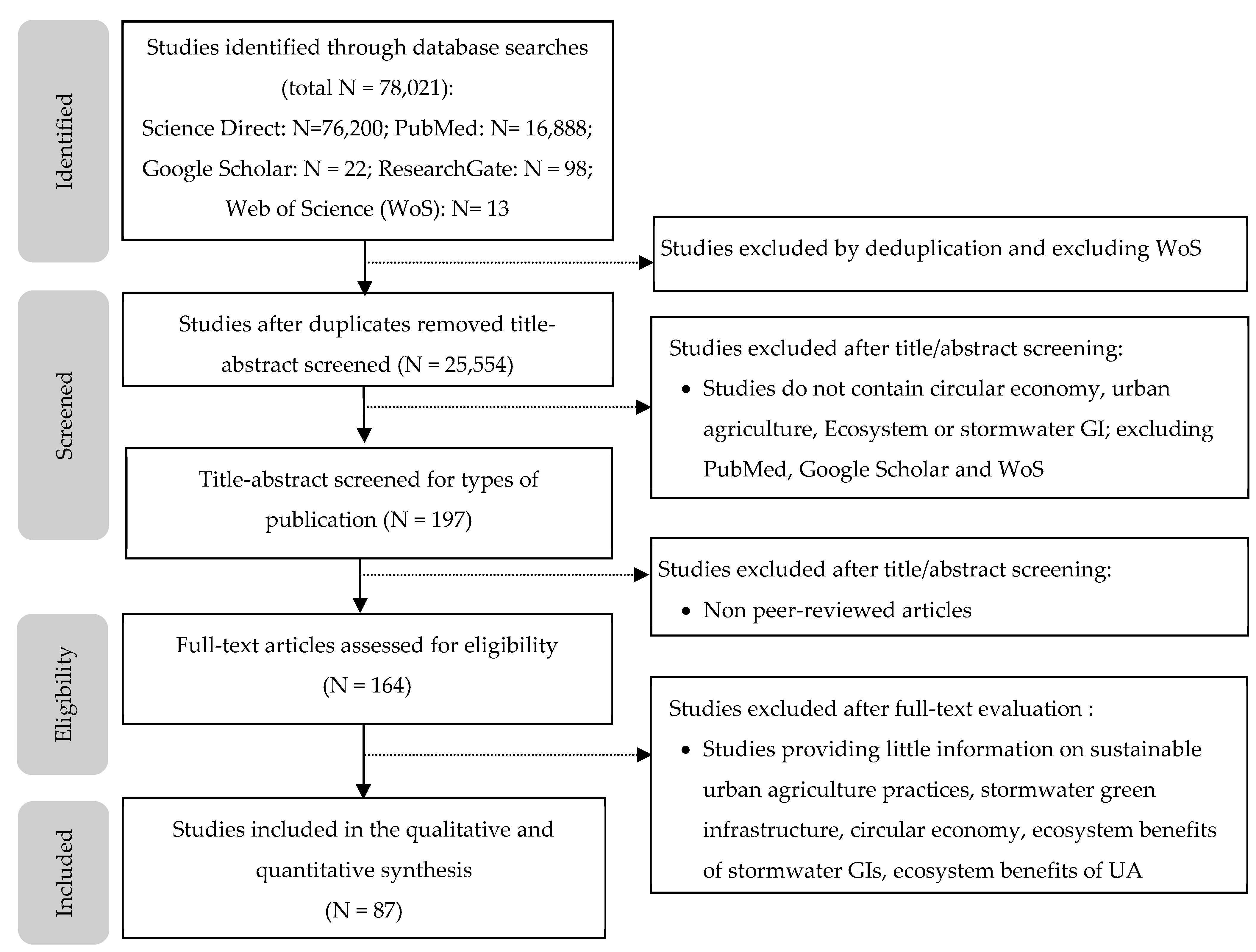
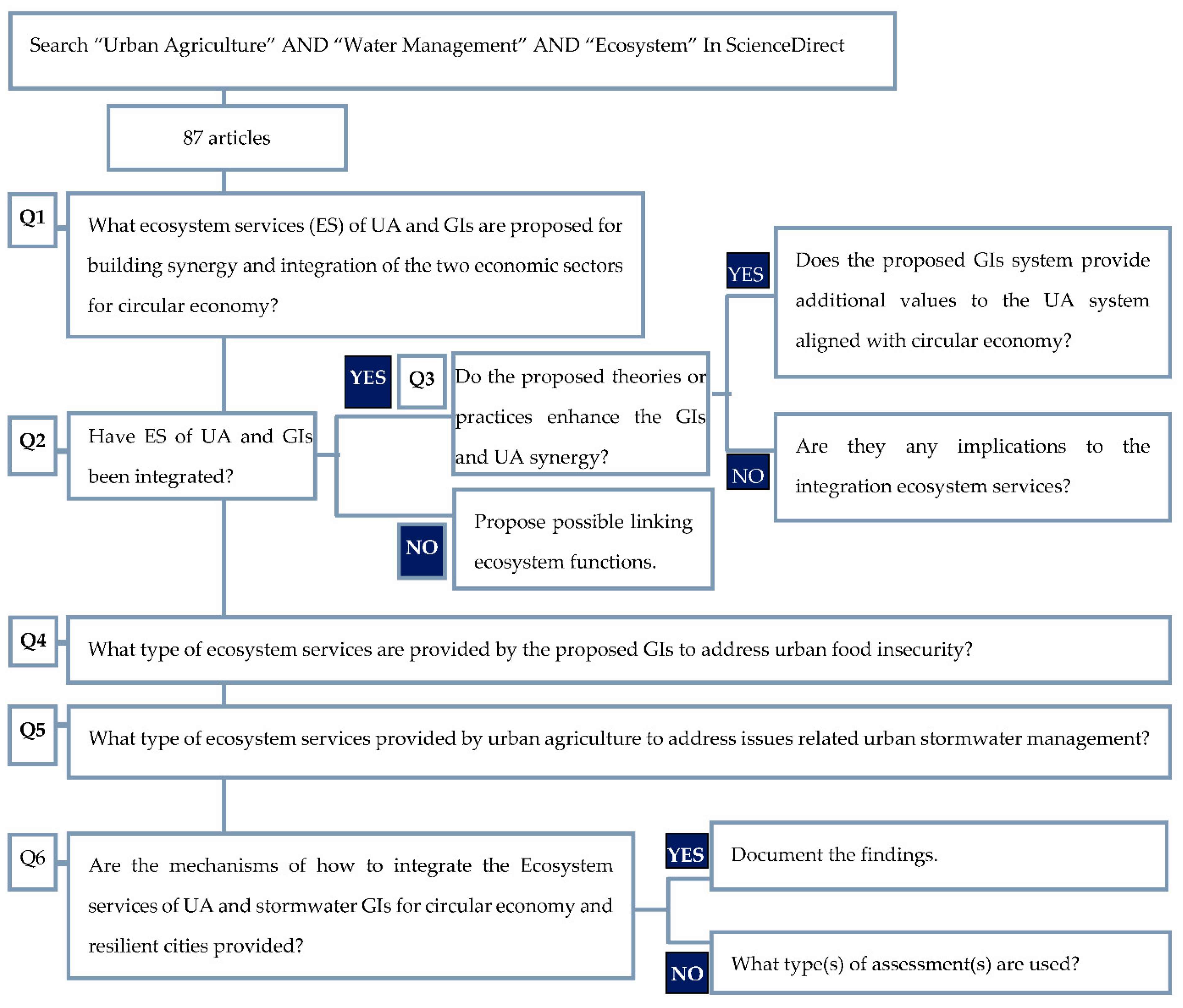
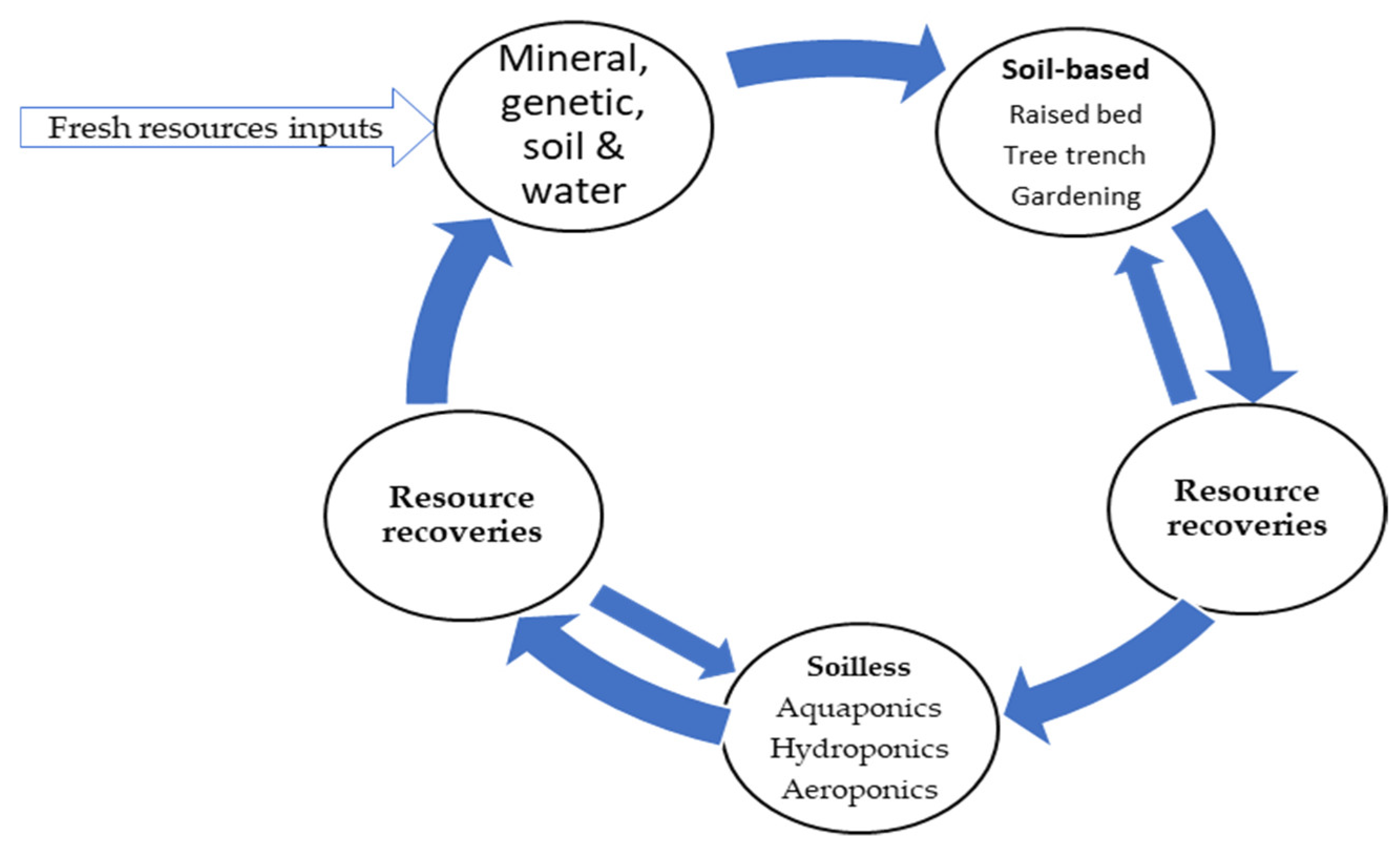
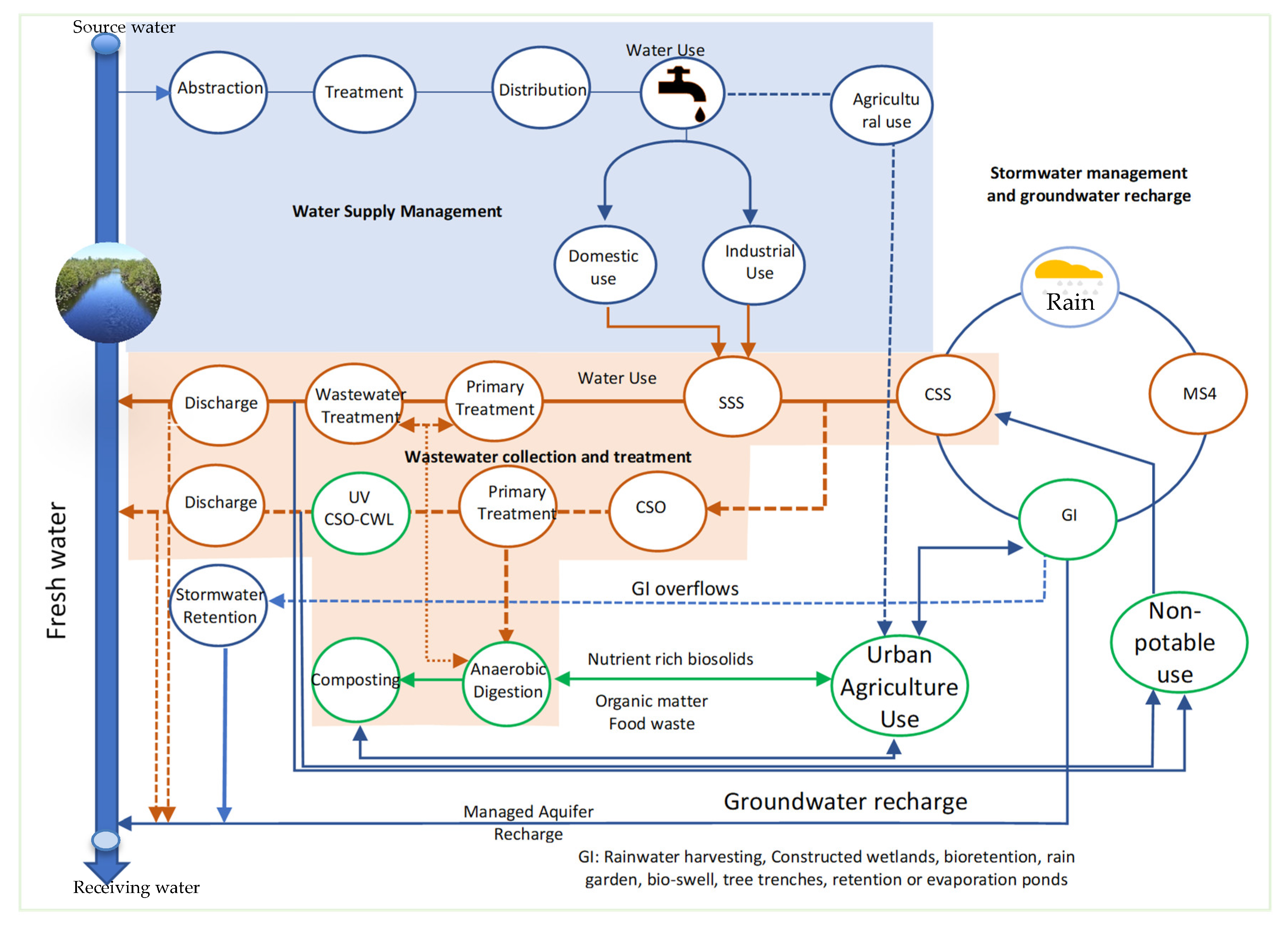
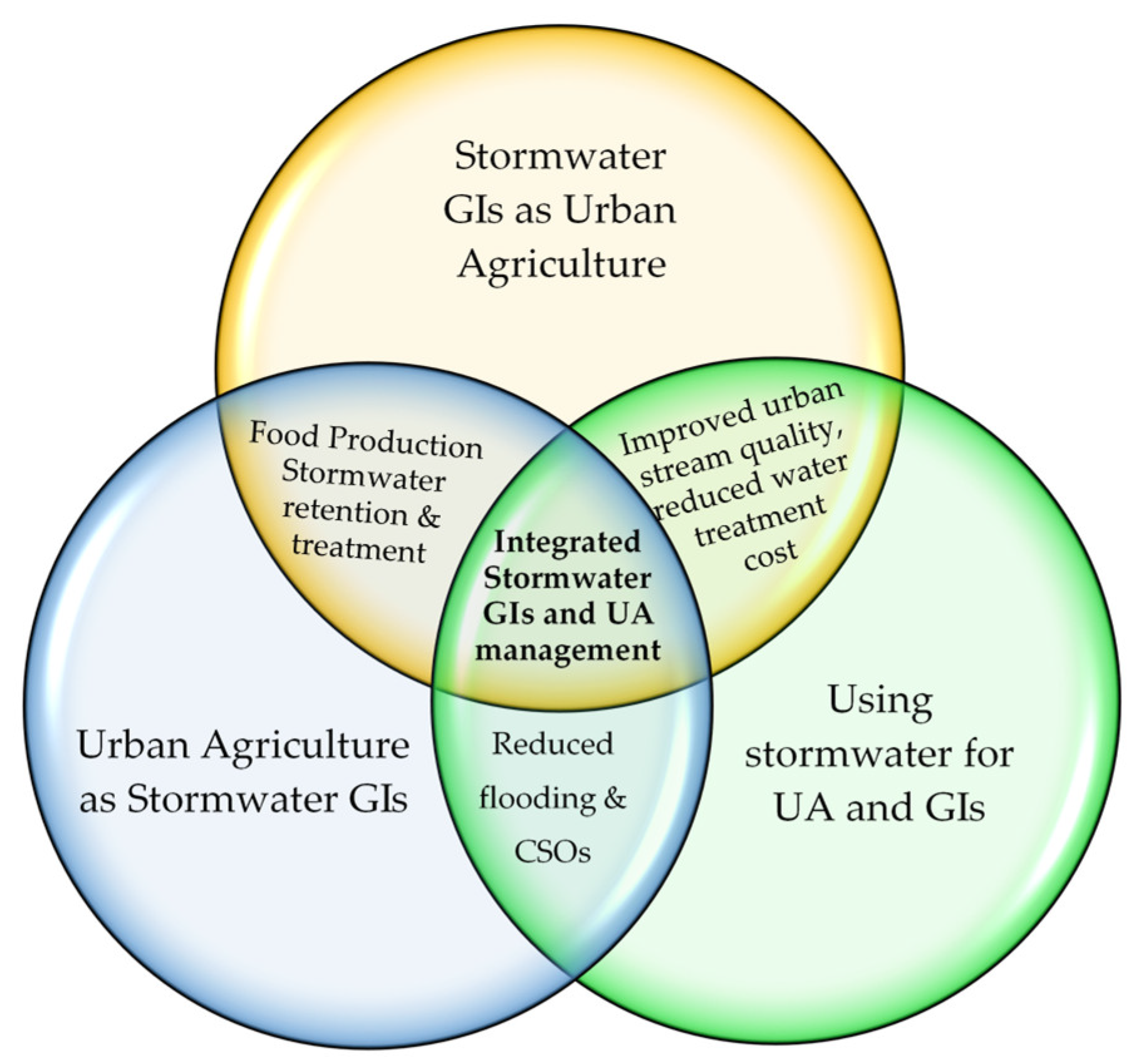
| Primary Term | Term Description | Search Terms | |
|---|---|---|---|
| Population | Urban Agriculture | Economic sector of interest | Urban farming, rooftop gardening, hydroponic, aquaponic, composting, and reclaimed water reuse |
| Stormwater Green Infrastructure | Environmental management of interest | Bioretention cell; green roof; rain garden; rainwater harvesting; urban trees; stormwater gray infrastructure; stormwater green Infrastructure | |
| Ecosystem Services | Environmental and socio-economic benefits of UA and GI | Ecosystem; Urban Ecosystem, Ecosystem Services | |
| Outcome | Urban ecosystem services | Environmental and socio-economic benefits of interest | Urban food production; stormwater retention; water quality improvement; |
| Agent | Water quality parameters | Water quality parameters of interest | Total nitrogen; total phosphorus; total suspended solids; trace metals |
| Fresh Produces | Urban food production of interest | Vegetable |
| Inclusion Criteria | Exclusion Criteria | |
|---|---|---|
| Study type | Review articles; Research articles, conference abstract; book chapters, discussion, editorial | Encyclopedia |
| Language | English | Non-English |
| Population | Urban ecosystem services (Urban Agriculture, Urban stormwater Management, Circular economy, Gray and Green Infrastructure, Ecosystem) | Non-Urban ecosystem services |
| Outcomes | Sustainable urban agriculture practices as means to provide food, reduce stormwater runoff or Green infrastructures as ways to produce food, retain stormwater runoff, and provide socio-economic benefits in a circular economy. | Non-urban agricultural or non-urban green stormwater infrastructure. |
| Study Period | 1997–2021 | Pre-1997 |
| Circular Economy Principles [40] | Water Systems Management | Examples of Stormwater Green Infrastructure | References |
|---|---|---|---|
| Principle 1: Design out waste externalities |
|
| [43,44,45,46,47,48] |
| Principle 2: Keep Resources in Use |
|
| [30,31,32] |
| Principle 3: Regenerate Natural Capital |
|
| [49,50,51] |
| Ecosystem Services | Example of Integrated Stormwater Management and Urban Agriculture | References | |
|---|---|---|---|
| Provision: | Food supply | Food-producing rain gardens and green roofs, urban fruit trees, urban food forest | [4,9,23,79,80] |
| Water supply (non-potable use for consumptive uses: harvested or reclaimed water) | Graywater reuse through bioretention, rainwater harvesting, using harvested water for agriculture to reduce water supply/demand. | [10,61,81] | |
| Wood and fiber | Urban forest | [82] | |
| Regulating: | Drinking water quality enhancement | Stormwater retention and filtration | [2,26,83] |
| Flood control | Bioretention, rainwater harvesting, using harvested water for agriculture | [2,26,83] | |
| Wastewater purification | Using hydroponic for food production and wastewater treatment | [40] | |
| Stormwater quality enhancement (N, P, coliform, total suspended solids) | Bioretention | [23,79] | |
| Air purification/air quality regulation | Urban trees, urban forest | [2,84,85] | |
| Carbon sequestration | Urban trees, urban forest | [84,85,86,87] | |
| Temperature regulation | Urban trees, urban forest | [2] | |
| Cultural: | Esthetic value | Urban fruit trees, green roofs, Bioretention, Tree trenches | [2,4] |
| Recreation | Bioretention, Tree trenches | [2] | |
| Educational opportunities | Green roofs, Bioretention, Tree trenches | [2,4] | |
| References | TN | TP | TSS | PAHs | Type of Study and Country | Addition of Enhancing Materials |
|---|---|---|---|---|---|---|
| Removal Efficiency (%) | ||||||
| [79] | 82 | 95 | 94 | Laboratory; Artificial rainfall, USA | ||
| [80] | 51 | 67 | 70 | Field Study, USA | ||
| [81] | 90 | Field Study, USA | Wood chips | |||
| [82] | 86 | Laboratory | ||||
| [83] | 64 | 89 | Field Study, China | |||
| [84] | 56 | Field Study, USA | ||||
| [84] | 95 | 94 | Laboratory, China | Fe-biochar | ||
| [86] | 80 | 95 | 95 | Field study, China | Zeolites | |
| [87] | 90 | 95 | Laboratory, Sweden | |||
| [89] | 84 to 100% | |||||
| [91] | 29.8–123.0 | Laboratory | ||||
Publisher’s Note: MDPI stays neutral with regard to jurisdictional claims in published maps and institutional affiliations. |
© 2021 by the authors. Licensee MDPI, Basel, Switzerland. This article is an open access article distributed under the terms and conditions of the Creative Commons Attribution (CC BY) license (https://creativecommons.org/licenses/by/4.0/).
Share and Cite
Deksissa, T.; Trobman, H.; Zendehdel, K.; Azam, H. Integrating Urban Agriculture and Stormwater Management in a Circular Economy to Enhance Ecosystem Services: Connecting the Dots. Sustainability 2021, 13, 8293. https://doi.org/10.3390/su13158293
Deksissa T, Trobman H, Zendehdel K, Azam H. Integrating Urban Agriculture and Stormwater Management in a Circular Economy to Enhance Ecosystem Services: Connecting the Dots. Sustainability. 2021; 13(15):8293. https://doi.org/10.3390/su13158293
Chicago/Turabian StyleDeksissa, Tolessa, Harris Trobman, Kamran Zendehdel, and Hossain Azam. 2021. "Integrating Urban Agriculture and Stormwater Management in a Circular Economy to Enhance Ecosystem Services: Connecting the Dots" Sustainability 13, no. 15: 8293. https://doi.org/10.3390/su13158293
APA StyleDeksissa, T., Trobman, H., Zendehdel, K., & Azam, H. (2021). Integrating Urban Agriculture and Stormwater Management in a Circular Economy to Enhance Ecosystem Services: Connecting the Dots. Sustainability, 13(15), 8293. https://doi.org/10.3390/su13158293





